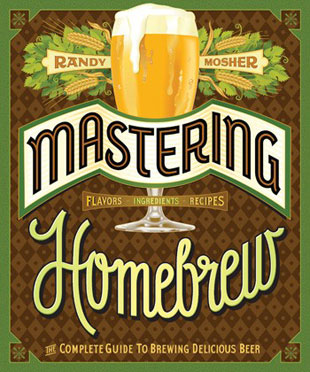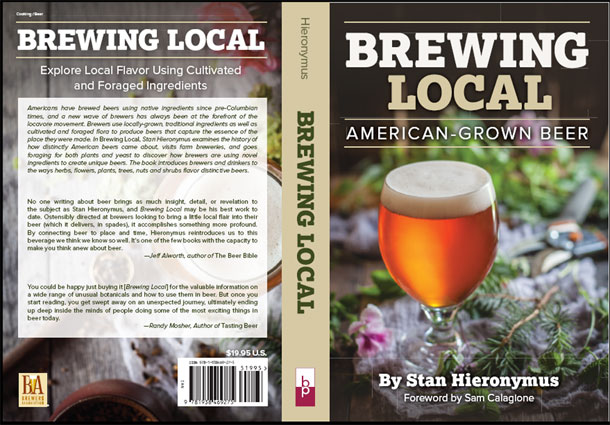My new desktop background.
books
Loose ends, beery and otherwise
Some short items that don’t fit neatly into Monday beer links or that, oops, I overlooked.
- When I pointed to Ron Pattinson’s “The Haight” last week and suggested you might find his travel books of interest I had no idea a new one was in the works. “Tour!” chronicles his travels through the United States during the last year-plus. I sure hope somebody at the Beer Bloggers Conference later week this points to the book (or the posts it represents) as the kind of blogging it would be nice to see more of. Because Pattison combines an actual point of view with clever writing.
- The downside to “hands on” brewing: brewers get hurt. Kerry Thomas, the brewmaster at Edge Brewing Company in Boise, Idaho, suffered 2nd and 3rd degree burns over 30 percent of her body while brewing Friday. Her friends and family have set up a relief fund at GoFundMe. Accidents involving burns are more common that most drinkers realize. Teri Fahrendorf has written about her own experience, an accident that occurred in 1989. (h/T @scratchbeer)
- Lagunitas founder Tony Magee is now blogging. Longer posts from a guy already adept at raising a ruckus 140 characters at a time.
- Jamie Goode has done the math and it works out that the grapes in a bottle of wine that sells for £3328 (about $5,154) cost £5.32 each (about $8.24). I tried to come up with some analogy that included hops or bourbon barrels or something and beer, but there really isn’t one that makes sense. Which is a good thing.
- Ingredients of the month: Cattails and rhubarb.
- Overlooked: pricenomics analyzed the beer listings of 6,000 bars and restaurants across the country and lists which beers predominate menus in which states. All this data must have left Bryan Roth in tears. Shocked Top Belgian White No. 1 in Idaho? Sierra Nevada Pale Ale tops in New Mexico but not California (Stella Artois instead)? And why does the PBR distributor in Houston still have a job?
Book review: Mastering Homebrew
 How many homebrewing books do you really need to own?
How many homebrewing books do you really need to own?
In the foreword to “Mastering Homebrew: The Complete Guide to Brewing Delicious Beer” Boston Beer Co. founder Jim Koch writes, “This book might just be the only brewing book most homebrewers will ever need.”
For personal reasons, I hope that most homebrewers don’t take that thought seriously.
There are a bunch of “if you were to buy only one homebrewing book this one will take care of all yours needs” books available, but it seems to me that “Mastering Homebrew” jumps immediately into what now constitutes a Big Three (I might as well mention now there is a disclaimer at the end). “How to Brew” and the recently revised “The Complete Joy of Homebrewing” are not only at the top of Books > Cookbooks > Food & Wine > Beverages & Wine > Beer at Amazon, but also the books you find in any decent homebrew shop.
I can see where somebody who has already worn out a copy of “How to Brew” and has a growing interest in sour beers would choose to buy “American Sour Beers” next, but I think a book that serves a beginner may offer value for even the most experienced homebrewer (in fact, commercial brewers as well). John Palmer (“How to Brew”), Charlies Papazian (“Complete Joy”) and Randy Mosher (“Mastering Homebrew”) think about beer differently, different than each other but, as important, different than you or I.
Within the early pages of his book, Mosher writes about “Brewing with Both Halves of Your Brain” and that “The first question is an existential one: Why is there beer? That answers will depend very much on your point of beer.”
He’s not always deadly serious. So “Doing It the Hard Way” (yes, that’s really the header on page 134, and it is a dive into mashing) is balanced with “Brewing the Perfect Party Beer” (Page 352).
 And if you bought a copy of Mosher’s “Brewer’s Companion” when it came out in 1993 some of the graphs and charts will look familiar, if a little fancier. Like “Radical Brewing” and “Tasting Beer” the book is beautifully illustrated, reminding us that Mosher is a graphic designer in real life. We’re not simply talking eye candy, but illustrations that, well, illustrate. The chart at the right makes it easy to visualize the balance between gravity and bitterness in various beer styles.
And if you bought a copy of Mosher’s “Brewer’s Companion” when it came out in 1993 some of the graphs and charts will look familiar, if a little fancier. Like “Radical Brewing” and “Tasting Beer” the book is beautifully illustrated, reminding us that Mosher is a graphic designer in real life. We’re not simply talking eye candy, but illustrations that, well, illustrate. The chart at the right makes it easy to visualize the balance between gravity and bitterness in various beer styles.
You can use the “Look inside” feature at Amazon to see the table of contents, but that only hints as how astonishingly complete this book it. (So you can see why Koch wrote what he did.)
*****
The disclaimer: My friendship with Randy Mosher is old enough to buy beer legally. In addition, he was the technical editor for “Brew Like a Monk,” for which I will always be in his debt, and he has said and written nice things about me on occasion.
Session #95: Have I got book ideas for you
 Three-time Session host Alan McLeod — the first three-time host — has offered a question for the 95th round that is delightfully easy for me to answer.
Three-time Session host Alan McLeod — the first three-time host — has offered a question for the 95th round that is delightfully easy for me to answer.
What is the book you would want to write about good beer?
I’m already at work on a book focused on indigenous beers of North America, past and present. Expect it from Brewers Publications in September of 2016.
There are plenty of other books I think somebody should write, so three quick suggestions:
– More indigenous. It’s a big world.
– More national or regional books like Martyn Cornell’s “Beer: The Story of the Pint: The History of Britain’s Most Popular Drink.” Memo to publishers:it is out of print and used copies are going for $40. Seems to indicate a level of reader interest.
– The last few days Jeff Alworth and McLeod have posted some year-in-review stats for Beervana and A Good Beer Blog respectively. A quick look here reveals that the best read post here is from almost seven years ago (gee, Stan, what have who written recently?): “Words to describe the beer you are tasting” (14,754 views). And I am pretty sure they are coming to read what I cribbed from the Merchant du Vin newsletter. No 2014 post attracted one third the attention (the top ones were all hop related). Does this demonstrate the need for an entire book? I’m pretty sure somebody clever could wrap a very interesting book around this topic, or use it to write something I would find totally silly and useless. Strangely intriguing.
Of course I’d like to see these books in print in English. That’s the language I read. But it should be obvious much of the research requires understanding other languages, making sense of things when Google Translate struggles.
If you decide to tackle one of these projects you are welcome for the ideas. You know you’ve got one customer. If you are looking other inspiration, then poke around the comments section at A Good Beer Blog. I fully expect to see something there I wish I’d thought of first. (Confession, I have a “Steal this idea” folder on Evernote.) But I’ve already got a book to write.
Public drinking, in context

Among the photos on page 105 of “Terminal Bar: A Photographic Record of New York’s Most Notorious Watering Hole” is one of a man with his chin resting ever so lightly on his closed right hand, looking like he could have been a silent screen star in the 1920s although the picture was taken in 1973.
The caption reads: “He used to come in on Saturdays, and the more he drank, the more lipstick he put on. He drank beer.”
That’s it. A reader is free to fill in the rest of the story.
Or there’s Charlie on pages 88 and 89, with beard and without; in 1977, in 1980, and at other times. “He once told me that these pictures of him were going to be valuable because he was going to do something. Every time he came in, he drank something else.”
So the description at Amazon simply doesn’t do “Terminal Bar” justice. “In 1972 Shelly Nadelman began a ten-year run bartending at one of New York City’s most notorious dives: the Terminal Bar, located across the street from the Port Authority Bus Terminal near Times Square. For ten years, right up until the bar closed for good in 1982, he shot thousands of black-and-white photographs, mostly portraits of his customers — neighborhood regulars, drag queens, thrill-seeking tourists, pimps and prostitutes, midtown office workers dropping by before catching a bus home to the suburbs — all of whom found welcome and respite at the Terminal Bar. This extraordinary archive remained unseen for twenty years until his son Stefan rescued the collection, using parts of it in a documentary short. Featuring nine hundred photographs accompanied by reminiscences in Shelly Nadelman’s inimitable voice, Terminal Bar brings back to life the 1970s presanitized Times Square, a raucous chapter of the city that never sleeps.”
At the time Termnal Bar was featured in the movie Taxi Driver it was known as being one of the roughest bars in the city. That was mostly a media fabrication, Nadelman says in this NPR interview, and instead he describes it as the gayest bar in New York.
It closed in 1982, and it appears there isn’t a sign of it remaining on Eighth Avenue. (If you were looking for a place with a wide beer selection you’d head for the nearby Beer Authority, but that’s a total aside.)
Describe “Terminal Bar” as a documentary if you’d like — 10 years in the life of a New York City bar and the lives of its regulars and its passers-through — or call it a book for the imagination.
*****
Disclosure: 1) I received this book after a PR person contacted me to see if I’d consider looking at it. 2) If I spotted it in a book store I would have bought after flipping through maybe a dozen pages. But this is a sort of book I’m predisposed to like.
